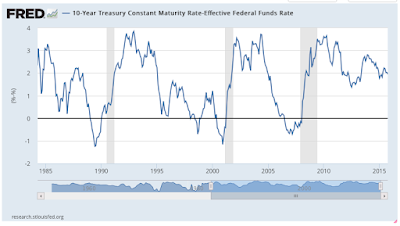In most advanced economies business cycles can be well characterized by a succession of long expansion phases that are interrupted by short recessions. Given this pattern it is sometimes natural to think about the length of expansions as a key feature that describes the business cycle. While other variables matter (such as the depth and length of recessions), in the case of the US and to some extent in the case of European countries, the parameter that has changed the most across cycles is the length of the expansion phase.
In the case of the US (using the NBER business cycle dates), in the post-WWII period expansions have lasted from 12 months in the expansion ending in 1981to 120 months in the expansion ending in 2001. The current expansion is already 77 months long, longer than the previous expansion of 2001-2007.
While counting months is not a good way to forecast the timing of the next recession it is at least a reminder that there is another recession waiting for us in the not-so-distant future. And when we start counting backwards to the next recession a key questions is whether we will be ready for it. In particular, will monetary policy be back to normal and able to react to it?
Interest rates have not yet moved away from zero in either Europe, the U.S. or Japan. This is, of course, very unusual given the length of the expansion. Another way to see how unusual monetary policy and interest rates look like is to plot the difference between long-term rates and the central bank rate.

For the case of the US we can see that this difference (the term premium) has stayed very high since the 2008-09 recession. Unlike in previous expansion where after two to four years the term premium started declining (mostly through increases in the short-term rate), in this case the number remains unusually high.
There is a positive reading of the chart that suggests that we are far from the next recession. Under the assumption that the term premium has to get very close to zero before a recession happens, it will take a while before we see the next one. But that reading ignores the fact that today short-term rates are not normal, they are stuck at the zero lower bound. Recessions do not happen because the term premium decreases, recessions happen for other reasons and it happens to be that the term premium moves with the cycle. But this expansion is not like the others because of the constraints on short-term rates so it might possibly be that the difference with long-term rates will this time be a really bad indicator of how close we are to a recession.












Leave A Comment